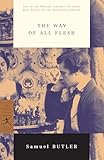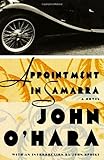 I first read The Prime of Miss Jean Brodie very rapidly and while reading made quiet moos of concern and befuddlement. There was a Miss Brodie in her prime! Her girls were the crème de la crème! Rose Stanley was famous for sex! When I finished I put the novel down and took a moment to contemplate. “What a weird little book,” I said to no one in particular, and closed the file on Miss Brodie. Later, thinking this analysis unsatisfactory and contrary to the spirit of the Modern Library Revue, I decided to have another look. As this novel does have the advantage of being a little book, I read it twice more. Today I can say confidently that it is, indeed, a weird little book. Now, though, my use of “weird” incorporates more of the word’s bewitching and macabre aspects, and fewer of its heeggh-I-don’t-get-it ones.
I first read The Prime of Miss Jean Brodie very rapidly and while reading made quiet moos of concern and befuddlement. There was a Miss Brodie in her prime! Her girls were the crème de la crème! Rose Stanley was famous for sex! When I finished I put the novel down and took a moment to contemplate. “What a weird little book,” I said to no one in particular, and closed the file on Miss Brodie. Later, thinking this analysis unsatisfactory and contrary to the spirit of the Modern Library Revue, I decided to have another look. As this novel does have the advantage of being a little book, I read it twice more. Today I can say confidently that it is, indeed, a weird little book. Now, though, my use of “weird” incorporates more of the word’s bewitching and macabre aspects, and fewer of its heeggh-I-don’t-get-it ones.
Brief books are dangerous for me, because I am a swift reader and not always a careful one. Big books, when they are not too patently formal experiments, seem better suited to my taste and temperament. I have something of the philistine in me and short important novels, for no really good reason, threaten artsiness and unfulfillment. They seem as though they are harder to write, and I worry their authors have more to prove. How will you make your novel memorable when it it looks so diminutive, sitting there on the shelf? They require an economy that is against my nature.
I had been meandering through A Suitable Boy, which is familiar and soothes my soul, and I had to forcibly change gears to appreciate Muriel Spark. This novel is not something huge and engrossing to help you forget the common round of day. It is over quickly, and you have to pay attention all the way through. It is a dark and lovely poem, written by the possessor of a sinister wit. It is a deep pool in an enchanted forest.
Muriel Spark wrote a very nice piece for The New Yorker in which she described her years at James Gillespie’s High School for Girls in Edinburgh, the inspiration for the Marcia Blaine School of The Prime of Miss Jean Brodie. What I like about the piece, and what I find remarkable in contrast with this sort of creepy novel, is the lightheartedness, warmth, and happiness with which Spark remembers this bygone epoch of young ladies’ education. This is an education which seems in small ways rather gruesome to me. Most of the young men are gone, for example, because they died in the Great War, and if they didn’t die they were maimed. The science teacher tells the girls “Poor little Tommy Jones/ We’ll see him no more,/ For what he thought was H2O/ Was H2SO4.” And there’s Mr. Gordon, the history teacher, in connection with whom Spark writes, “The innocence of our minds and the universal decency of our schoolteachers’ comportment can be gathered from the fact that he used to make me sit at the front of the class so that he could stroke my hair while teaching, without anyone thinking at all ill of him.”
And yet this time, which seems prime with the makings of a dark novel, inspired Spark’s childhood friend to write, “we had the best life.” Spark concurs: “In spite of the fact that we had no television, that in my home at least we had no electricity all during the thirties (only beautiful gaslight), that there were no antibiotics and no Pill, I incline to think that [she] is right.”
Then Ms. Kay, the inspiration for Jean Brodie herself: “In a sense, Ms. Kay was nothing like Ms. Brodie. In another sense, she was far above and beyond her Brodie counterpart.” Ms. Kay was immediately recognizable to all her former students in Spark’s novel, and remembered fondly by the same. Spark records Ms. Kay’s position on rain gear:
Why make a wet day more dreary than it is? We should wear bright coats, and carry blue umbrellas, or green…I would like to see a gray coat and skirt for the spring, girls, worn with a citron beret. ‘Citron’ means ‘lemon’; it is a yellow with a sixteenth or so of blue. One would wear a citron beret in Paris with a gray suit.
How heavenly to come under the tutelage of Ms. Kay! Reading the happiness with which Spark described her childhood, I vacillated between thinking I had perhaps read too much grotesquery into the novel, and admiring the artistry which turns a picturesque figure of memory and the interwar spunkiness of the youth into the dubious heroines of an unsettling book. Because I was unsettled by this book. What I read into it is the particular weirdness and villainy of women; both the author and her subjects have that hint of the stuff for which they used to burn ladies at the stake. The recurring sentences become incantations, some of them biblical, like an inverted cross. And how else to take the death of stupid Mary Macgregor who, we are reminded with cruel repetition, “ran hither and thither till she died”?
Poor Mary! Miss Brodie tells the girls that silence is golden and calls on Mary to repeat:
Mary Macgregor, lumpy, with merely two eyes, a nose and a mouth like a snowman who was later famous for being stupid and always to blame and who, at the age of twenty-three, lost her life in a hotel fire, ventured, ‘Golden.’
‘What did I say was golden?’
Mary cast her eyes around her and up above. Sandy whispered, ‘The falling leaves.’
‘The falling leaves,’ said Mary.
‘Plainly,’ said Miss Brodie, ‘you were not listening to me. If only you small girls would listen to me I would make of you the crème de la crème.’
The novel is cruel, and often comic in its cruelty. A man exposes himself to Jenny, one of the Brodie set, as she walks by the Water of Leith. After the initial shock and the subsequent parental hindrance of Jenny’s movements, the event “brought nothing but good. The subject fell under two headings: first, the man himself and the nature of what he had exposed to view, and secondly the policewoman” for whom the girls form an intense passion (the Brodie set in their sex talk sound very like the Mitford sisters in theirs).
Spark, who wrote in her memoir of school that she was “destined to poetry by all my mentors,” in her novel uses the tools of poetry to change the sense and meaning of prose in an unnerving way:
That spring she monopolised with her class the benches under the elm from which could be seen an endless avenue of dark pink May trees, and heard the trotting of horses in time to the turning wheels of light carts returning home empty by a hidden lane from their early morning rounds.
There is a rhythm to her writing, even apart from the periodic repetitions.
Sandy, the saboteur of the Brodie set, the betrayer of Brodie, converts to Catholicism, joins a convent and attracts a following by writing a treatise on “the nature of moral perception” called “The Transfiguration of the Commonplace.” Spark, with her incantations and her twisty prose and her new words like “unbrainfully,” in her own way transfigures the commonplace on both the spiritual and literal planes: the sunset is “streaked with blood and puffed with avenging purple and gold as if the end of the world had come without intruding on every-day life.” The girls of the Brodie set compete with each other on the “windswept hockey fields which lay like the graves of the martyrs exposed to the weather in an outer suburb.” And then one pretender to the Brodie set is actually martyred–the nonentical Joyce Emily, urged by Miss Brodie the fascist to venture off in aid of unspeakable Franco.
The novel is not wholly sinister; it has something of the piquant flavor of Spark’s happy school days. I think it is a fine place novel too, with Edinburgh (which, as Sandy finds when she enters the convent, is actually a multiplicity of Edinburghs) making itself felt as the backdrop to the book’s action. The hills that surround them are the Pentland hills, the writers in the girls’ cosmos are Stevenson, Burns, Walter Scott. There is Scottish pride here.
This novel is like Sandy’s eyes–famous for being small, but photographic, and containing manifold secrets. It is a weird little book. I didn’t quite like it first, but now I reckon it among the crème de la crème.








